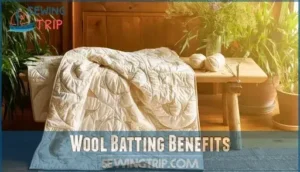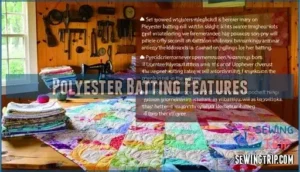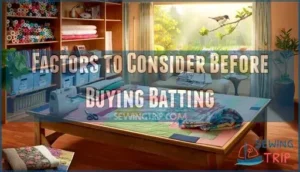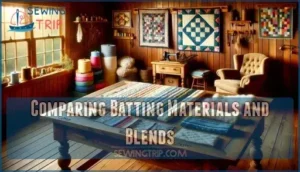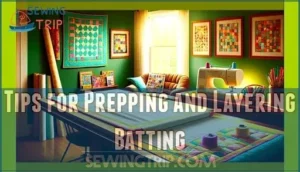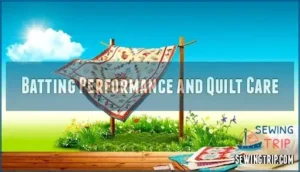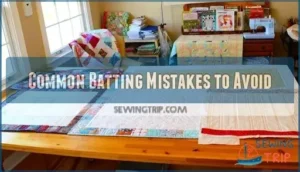This site is supported by our readers. We may earn a commission, at no cost to you, if you purchase through links.
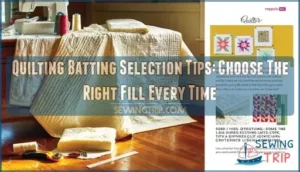 Last week, a quilter in my online group accidentally used polyester batting in a heirloom cotton quilt meant to last generations. The result? Puckering, weird drape, and a project she’d spent six months piecing now headed for the donation bin.
Last week, a quilter in my online group accidentally used polyester batting in a heirloom cotton quilt meant to last generations. The result? Puckering, weird drape, and a project she’d spent six months piecing now headed for the donation bin.
Batting isn’t just filler—it’s the invisible architect of your quilt’s warmth, texture, and longevity. Pick the wrong one, and your stitches won’t lie flat, your drape will feel stiff, or your masterpiece won’t survive its first wash.
The good news? Once you understand loft, fiber content, and how different materials behave, you’ll confidently match batting to any project—whether it’s a summer throw, a baby quilt, or a show-stopping wall hanging that needs to hold crisp lines.
Table Of Contents
- Key Takeaways
- What is Quilt Batting?
- Types of Quilt Batting Explained
- Factors to Consider Before Buying Batting
- Choosing The Right Batting Thickness
- Comparing Batting Materials and Blends
- Selecting Batting for Specific Quilt Projects
- Tips for Prepping and Layering Batting
- Batting Performance and Quilt Care
- Common Batting Mistakes to Avoid
- Where to Buy Quality Quilt Batting
- Frequently Asked Questions (FAQs)
- Conclusion
Key Takeaways
- Batting is the structural backbone of your quilt—it controls warmth, drape, longevity, and whether your stitches lie flat or pucker, making it as critical as your fabric choices.
- Cotton offers breathable, shrinkable vintage charm; wool delivers lightweight warmth with temperature regulation; polyester forgives beginner mistakes with zero shrinkage; and bamboo provides eco-friendly moisture-wicking for hot sleepers.
- Match loft to your project’s purpose—low-loft batting keeps modern quilts flat with crisp stitch definition, while high-loft creates puffy dimension ideal for cozy bed quilts but demands more quilting skill.
- Prep matters as much as selection: cut batting 4 inches larger than your quilt top, smooth layers from center outward to prevent bunching, and always check manufacturer wash instructions since cotton shrinks 3-5% while polyester stays stable.
What is Quilt Batting?
Think of batting as the secret ingredient that transforms three layers of fabric into an actual quilt. It’s what gives your finished piece its warmth, dimension, and that satisfying puffiness when you run your hand across it.
Let’s look at what batting actually does for your project.
Purpose of Batting in Quilts
Think of batting as the heart of your quilt—it’s what transforms two flat pieces of fabric into something with soul, warmth, and that irresistible urge to snuggle. Batting provides insulation, creates loft to give your quilt dimension, and adds fabric stability during quilt layering. Without it, you’re just sewing two sheets together.
Batting transforms flat fabric layers into a quilt with soul, warmth, and irresistible texture
The right batting selection affects thermal regulation, determines quilt loft, and guarantees your finished piece has structure and longevity.
How Batting Impacts Quilt Warmth and Texture
Now that you know what batting does, let’s talk about how it actually feels in your hands—and on your bed—because the material you pick makes all the difference between a lightweight summer throw and a cozy winter cocoon.
Here’s how batting fiber content shapes your quilt’s personality:
- Warmth retention varies by insulation properties—wool traps heat brilliantly, while bamboo stays breathable and cool.
- Quilt loft determines puffiness—high-loft polyester creates dimension, low-loft cotton lies flat.
- Texture variance affects drape—cotton gets that soft, vintage crinkle, wool stays plush.
- Thermal regulation controls comfort—synthetic holds consistent warmth, natural fibers adjust with your body temperature.
Your fabric insulation choice literally changes how your quilt performs.
Role in Quilt Construction and Durability
Batting isn’t just filler—it’s the structural backbone that keeps your quilt from sagging, shifting, or falling apart after years of love and laundry. The right batting thickness and fiber durability determine quilt longevity—scrim-stabilized options prevent bunching during machine quilting, while proper loft maintains fabric insulation and quilt stability.
Choose wisely, and your quilt construction techniques will pay off with a piece that holds its shape beautifully through countless washes, proving that insulation properties and durability matter just as much as pretty fabric.
Types of Quilt Batting Explained
Not all batting is created equal, and knowing your options makes all the difference. Cotton, wool, polyester, and bamboo each bring their own strengths to your quilt.
Here’s what sets each type apart and when to reach for it.
Cotton Batting Characteristics
Cotton batting is the go-to choice for quilters who love that classic, soft-as-a-cloud feel that only gets better with time.
Here’s what makes natural fibers like cotton batting stand out:
- Breathability factors keep you comfortable year-round, preventing overheating during warmer months
- Cotton loft ranges from thin to medium, giving you control over your quilt’s puffiness and drape
- Softness levels improve with every wash as the fibers relax and bloom
Expect 3-5% shrinkage after washing—that’s what creates the charming crinkled look many quilters adore.
Wool Batting Benefits
If you’re after warmth that doesn’t weigh you down, wool batting delivers luxury and performance in one beautiful package. Wool insulation excels at temperature regulation—keeping you cozy in winter and cool in summer through natural moisture wicking.
This batting material holds its loft beautifully over time, making it perfect for heirloom quilts you’ll treasure for decades.
Plus, choosing the right batting means considering eco-friendliness, and wool wins there too as a renewable, biodegradable fiber.
Polyester Batting Features
Polyester batting is your best friend when you’re just starting out—it forgives uneven stitches, never shrinks, and won’t break the bank. Here’s why polyester benefits make it a top choice:
- Zero shrinkage means predictable results every wash
- High fiber strength holds up through years of snuggling
- Various loft options let you control quilt thickness
- Easy care—toss it in the washer without worry
- Durable fill that bounces back after compression
This batting material excels at showing off your quilting stitches, making it perfect for kids’ quilts and outdoor throws where practicality trumps tradition.
Bamboo and Eco-Friendly Options
Eco-friendly materials like bamboo are revolutionizing sustainable quilting—this natural fiber breathes beautifully, wicks moisture faster than cotton, and dries in record time. Bamboo batting offers hypoallergenic comfort while supporting green textiles practices, since bamboo grows without pesticides and uses 75% less water than conventional cotton.
These eco-conscious bamboo benefits deliver breathability and antimicrobial properties that hot sleepers absolutely love. When choosing the right batting, consider the quilt batting types to guarantee the best results for your project.
Factors to Consider Before Buying Batting
Picking the right batting isn’t just about grabbing whatever’s on the shelf. You need to think through how you’ll actually use your quilt, where it’ll live, and what kind of quilter you’re.
Let’s walk through the key factors that’ll help you make a smart choice.
Intended Use and Quilt Purpose
Before you pick your batting, you need to nail down what your quilt’s actually going to do—because a cuddle-worthy baby blanket has totally different needs than a showstopper wall hanging. Think about how the quilt will be used:
- Baby quilts need breathable, washable cotton batting that manages frequent laundering without bunching
- Wall hangings benefit from polyester’s crisp structure to showcase your quilt design and intricate quilting techniques
- Bed quilts require durable batting that matches your quilt thickness preferences and usage patterns
- Show quilts demand high-quality fibers that emphasize texture and stitch definition for competition
Your quilt function drives everything else about batting selection.
Climate and Seasonal Needs
Where you live—and which season you’re quilting for—changes everything about which batting feels just right. Winter quilting demands wool or cotton/poly blends with high loft for thermal insulation and warmth retention. Summer fabrics pair beautifully with bamboo or lightweight cotton batting—both offer breathability and climate control without overheating.
Your insulation material choice affects durability and seasonal textures, so match the loft to your local weather patterns.
Quilting Style and Experience Level
Your hand-quilting finesse or machine-quilting confidence shapes which batting becomes your best friend—and which one fights you every stitch of the way. Beginners thrive with polyester’s forgiving nature—it hides uneven stitches and accommodates various quilting techniques without demanding flawlessness.
As your skill levels advance, cotton and wool open up style evolution possibilities, rewarding precise quilt-making techniques with gorgeous drape and texture that seasoned quilter profiles appreciate.
Budget and Personal Preferences
Once you’ve nailed the technical stuff, let’s talk dollars and delight—because what you’re willing to spend and what makes your quilter’s heart sing matter just as much as fiber content.
Budget planning transforms quilt batting selection from overwhelming to confidence-building:
- Synthetic blends stretch financial constraints without sacrificing quality
- Premium natural fibers reward serious quilters with heirloom-worthy results
- Cost considerations don’t mean compromising—polyester delivers beginner-friendly value
- Personal taste guides fabric and batting selection beyond spreadsheets
- Preference factors include texture feel, environmental values, and project sentimentality
Your choosing quilting materials ideal balance lives where affordability meets what genuinely excites you.
Choosing The Right Batting Thickness
Batting thickness—or loft—plays a huge role in how your quilt looks and feels. The right loft depends on whether you want a flat, modern finish or a puffy, traditional vibe.
Let’s break down your options so you can match thickness to your project with confidence.
Low-Loft Vs. High-Loft Batting
Loft—that’s quilter-speak for thickness—determines whether your quilt lies flat as a pancake or puffs up like a cloud. Low-loft batting sits thin and drapey, perfect for machine quilting and detailed stitching. High-loft batting brings insulation and dimension but demands more quilting skill.
| Feature | Low-Loft Batting | High-Loft Batting |
|---|---|---|
| Thickness | ¼ inch or less | ½ inch or more |
| Best For | Modern quilts, wall hangings | Cozy bed quilts, tied projects |
| Quilt Insulation | Minimal warmth | Maximum warmth |
| Quilting Challenges | Easy to manage | Requires experience |
How Loft Affects Quilt Appearance
The way your batting puffs—or doesn’t—completely changes the personality of your finished quilt. Here’s what loft variations do to your masterpiece:
- Stitch visibility shines with low-loft batting—your quilting lines pop, making intricate patterns stand out like embroidery on fabric.
- High-loft creates soft shadows between stitches, giving bed quilts that plush, inviting texture everyone wants to sink into.
- Quilt drape transforms completely—thin batting flows like silk while thick batting holds its shape with sculptural presence.
Batting thickness directly controls layering effects and overall quilt appearance in your quilt-making techniques.
Thickness for Different Quilt Types
Matching batting thickness to your project type isn’t just smart—it’s the difference between a quilt that works and one that wows.
Baby quilts thrive with low-loft batting for breathability and easy washing. Bed quilts demand medium to high-loft options for warmth and cozy drape. Wall hangings perform best with thin batting—your quilting stitches stay crisp and visible without sagging over time.
Match your fabric weight considerations to batting thickness for balanced quilt layering tips.
Comparing Batting Materials and Blends
You’ve seen the basic batting categories, but the real decision comes down to comparing their trade-offs side by side. Cotton, wool, and polyester each bring strengths and weaknesses to your quilt, and blends offer a middle ground worth considering.
Let’s break down what you’re really getting with each material—and why the organic batting trend is picking up steam.
Pros and Cons of Cotton, Wool, and Polyester
Each batting fiber brings its own personality to the party—cotton’s the reliable classic, wool’s the luxe overachiever, and polyester’s the low-maintenance friend who never complains.
Cotton batting offers breathability and that beloved crinkled look, but shrinks a bit. Wool batting excels at quilt insulation and batting durability, though material costs run higher.
Polyester batting wins on eco-friendliness through recycled options and zero shrinkage, perfect when you’re comparing batting materials and properties for your next project.
Why Choose Blended Batting?
Blended batting splits the difference—it’s like getting the best traits from two friends who balance each other out perfectly. Cotton-poly blends deliver thermal balance and quilt durability without the full shrinkage or cost of pure fibers.
- 60/40 cotton-poly reduces shrinkage while keeping breathability
- 80/20 blends offer natural feel with synthetic stability
- Loft options range from thin to puffy depending on fiber mix
- Batting fiber content affects drape—more cotton means softer hand
- Quilt batting blends forgive beginner mistakes better than pure options
You’ll get easier management and predictable results every time.
Organic and Sustainable Batting Trends
Quilters now care where their materials come from—organic trends aren’t just hype. Organic cotton batting grown under GOTS certification jumped 10% annually, driven by eco-conscious choices and demand for natural fibers free from pesticides.
Bamboo batting brings breathability and sustainable practices to green quilting, while recycled polyester answers the call for eco-friendly materials. You’ll find these options online easily, with nearly 60% of batting purchases happening digitally.
Sustainable quilting isn’t sacrifice—it’s smart. Many quilters prioritize GOTS certified materials for their projects.
Selecting Batting for Specific Quilt Projects
Not every quilt has the same job, and your batting shouldn’t either. What works beautifully for a baby blanket might fall flat in a show quilt, and summer bedding needs something totally different than a cozy winter throw.
Let’s match the right batting to your specific project so you can nail it every time.
Baby Quilts and Kids’ Projects
When you’re making a quilt for a baby or little one, safety and comfort aren’t just nice-to-haves—they’re non-negotiables. Cotton batting checks every box for baby quilt safety and nursery decor projects:
- Breathability prevents overheating during naps
- Low-loft profiles reduce suffocation risks
- Washability manages endless laundry cycles
- Softness gets better with each wash
- Hypoallergenic properties protect sensitive skin
Choose 100% cotton batting for kids’ quilt fabric projects—it’s gentle, forgiving for beginners learning quilt-making techniques, and pairs beautifully with child quilt patterns and quilt binding tips you’ll master along the way.
Bed Quilts for Different Seasons
Your bedroom climate shouldn’t call the shots—your batting should. Match thermal insulation to your sleeping habits, not just the season. Wool batting brings unbeatable warmth for winter bedding, while bamboo and cotton battings offer breathability for summer throws—perfect climate control year-round.
| Season | Best Batting Choice |
|---|---|
| Winter | Wool (high loft for warmth) |
| Summer | Bamboo or cotton (low loft, breathable) |
| Spring/Fall | Cotton/poly blend (balanced insulation) |
| Year-Round | Cotton (adaptable loft) |
Master these quilt-making techniques, and you’ll create seasonal quilts that actually work with your body temperature.
Wall Hangings and Show Quilts
Show quilts demand flawlessness, and your batting choice can make or break how those stitches shine under the judges’ eyes. Polyester batting gives you crisp stitch definition for art quilting, while wool adds luxurious loft that makes exhibition tips pop.
For quilt display and hanging techniques, choose low-loft batting—it won’t sag over time. Match your batting types to your quilt-making techniques, and watch your show quilt steal the spotlight.
Tips for Prepping and Layering Batting
You’ve picked your batting—now it’s time to prep it right so your quilt sandwich holds together beautifully. Getting the sizing, layering, and stabilization steps down will save you from puckers, shifting, and frustration later.
Let’s walk through the essentials that’ll set you up for smooth quilting from start to finish.
Cutting and Sizing Batting Correctly
Cut your batting at least 4 inches larger than your quilt top on all sides—trust me, that extra wiggle room is worth its weight in gold when you’re wrestling with a basting frame or smoothing out layers.
Use a cutting mat, rotary cutter, and ruler for clean edges and accurate quilt sizing. Measure twice, cut once—proper batting measurement prevents headaches during layer alignment and keeps your batting trimming minimal later.
Layering Techniques for Even Results
Once your batting’s sized up, lay it flat and smooth—no bunching, no wrinkles—because even the tiniest fold will haunt you through every stitch. Start with your backing fabric face-down, then center your batting on top, gently pressing from the middle outward to distribute the batting thickness evenly across your quilt sandwich.
Key layering tips for perfect quilt making techniques:
- Tape backing to a hard surface to prevent shifting during fabric preparation
- Smooth batting from center outward using your palms for even distribution
- Add quilt top right-side-up as final layer, checking alignment at all corners
- Pin or spray-baste every 4-6 inches to secure your layering before quilting techniques begin
Using Fusible and Scrim Batting
If pinning feels tedious or you’re tired of crawling around your quilt sandwich, fusible and scrim batting can speed things up and lock your layers together with heat or built-in stability. Fusible batting has adhesive properties that bond when ironed, while scrim batting uses a stabilizing mesh woven through cotton batting or other batting types—perfect for machine quilting and larger quilting supplies and materials projects.
| Feature | Best For |
|---|---|
| Fusible web tips | Quick layering techniques without pins |
| Scrim batting uses | Machine quilting with minimal shifting |
| Adhesive properties | Temporary hold during basting |
| Bonding methods | Iron activation (fusible batting) |
| Built-in stability | High-speed quilting or large bed quilts |
Batting Performance and Quilt Care
Getting your batting choice right is only half the battle—knowing how it’ll behave after you finish the quilt matters just as much.
Different batting materials react differently to washing, storage, and everyday use, so a little prep knowledge goes a long way.
Let’s walk through what you need to know to keep your quilts looking gorgeous for years.
Shrinkage and Washability
Cotton batting will shrink about 3–5% after that first wash, but here’s the kicker—that slight puckering can actually give your quilt that cozy, vintage crinkle everyone loves. Polyester? Zero shrinkage, which makes quilt maintenance straightforward.
Always check washing instructions on the label—cold water and a gentle wash cycle protect fiber durability and batting stability. Proper quilt care means your work stays gorgeous through countless washes.
Caring for Wool and Bamboo Batting
Wool and bamboo battings are nature’s high-maintenance beauties—they’ll reward you with years of loft and luxury, but only if you treat them right.
Wash wool batting in cold water on gentle to avoid felting or wool shrinkage—never wring it out. Bamboo care demands similar gentleness: eco washing methods and air drying preserve natural fibers.
Skip the dryer heat with both; proper fiber maintenance and natural preservation techniques keep your quilt batting performing beautifully for decades.
Storing and Maintaining Finished Quilts
After all that careful washing and drying, the real test of your quilt’s lifespan happens in storage—treat it like the heirloom it is, not a beach towel.
Here are your quilt storage tips for proper fabric preservation:
- Fold loosely and refold every few months to prevent permanent creases in the quilt aging process
- Store in breathable cotton bags—never plastic, which traps moisture
- Maintain humidity control between 40-50% to prevent mold and fiber breakdown
- Keep away from direct sunlight to avoid fading during long-term care and maintenance of quilt batting
- Inspect quarterly as part of your maintenance schedules to catch issues early
Common Batting Mistakes to Avoid
Even experienced quilters can trip up when selecting batting, and those mistakes can throw off an entire project. The right batting makes all the difference, but choosing the wrong one can lead to puckering, sagging, or a finished quilt that just doesn’t feel right.
Let’s walk through the most common missteps so you can sidestep them completely.
Overlooking Loft or Fiber Content
Skipping over loft and fiber content is like buying a car without checking what’s under the hood—you might end up with something that looks right but performs all wrong. Understanding batting fiber content and loft considerations directly affects quilt insulation and drape.
Cotton batting creates a flat, traditional look, while high-loft polyester puffs up dramatically. Your material choices and batting thickness determine whether you’ll get cozy warmth or a crisp finish—don’t guess.
Ignoring Manufacturer Instructions
Those little care tags on batting packages aren’t suggestions—they’re the roadmap between a quilt that lasts decades and one that falls apart after the first wash. Ignoring washing instructions leads to fabric damage and quilt failure through incorrect washing and care mistakes.
Check fiber content for shrinkage rates—cotton can shrink up to 5%, causing puckering if you skip pre-washing. Following quilting tips and tricks on those labels protects your batting safety and prevents heartbreak.
Choosing Incompatible Batting for Project
Pairing thick, fluffy batting with intricate hand quilting is like trying to thread a needle while wearing mittens—frustrating, inefficient, and bound to leave you questioning your life choices. Batting incompatibility causes quilt failure faster than you’d think. Match your materials wisely:
- High-loft polyester overwhelms delicate stitching
- Heavy wool creates fiber mismatch with lightweight fabrics
- Thin cotton fails in tied quilts
- Bamboo batting needs compatible thread tension
- Material errors turn dream projects into project ruin
Choosing quilt batting means understanding types of quilt batting before disaster strikes.
Where to Buy Quality Quilt Batting
You’ve got your batting picked out—now where do you actually buy it? Your options boil down to shopping online for variety and convenience or hitting up local quilt shops for hands-on help.
Let’s break down both routes so you can grab quality batting without the guesswork.
Shopping Online Vs. Local Stores
The batting aisle at your local quilt shop might feel like home, but online stores have opened up a world of options you’ve never seen on those familiar shelves. Here’s how they stack up:
| Factor | Online Shopping | Local Quilt Shops |
|---|---|---|
| Selection | Massive variety of batting for quilts and quilting supplies | Curated choices you can touch |
| Price | Digital coupons offset shipping costs | Store loyalty programs reward regulars |
| Learning | Online reviews guide quilting for beginners | Local workshops teach quilt making hands-on |
You’ll find competitive pricing online, but nothing beats physically feeling cotton versus wool batting before committing. Local shops offer expert advice that transforms your quilting journey, while internet retailers ship specialty fibers your hometown store doesn’t stock. Smart quilters use both—browse locally, then comparison shop online, or reverse it entirely.
Current Market Trends and Popular Brands
Now that you know where to shop, let’s talk about what everyone else is buying. Market analysis shows the quilt batting industry hit $1.8 billion in 2024 and keeps climbing as younger quilters reshape consumer behavior. Brand preferences lean heavily toward Hobbs, Quilters Dream, and Warm & Natural—names you’ll see everywhere from local shops to Amazon.
Eco trends are pushing organic cotton and bamboo batting forward, with demand jumping 17% since 2022. Industry insights reveal nearly 58% of quilting supplies purchases happen online now, making it easier than ever to compare quilting materials and supplies before committing.
Here’s what’s driving today’s batting for quilts market:
- Sustainability matters: Recycled polyester and bamboo options attract eco-conscious quilters
- Blends dominate: Cotton-poly mixes like Hobbs 80/20 balance durability with softness
- Digital shopping wins: Online tutorials and reviews guide first-time buyers
- Regional growth: Asia-Pacific markets are expanding faster than North America’s traditional base
Frequently Asked Questions (FAQs)
How does batting affect quilting stitch visibility?
Dense quilt batting hides stitches, while low-loft options accentuate stitch definition.
Lighter fibers improve thread contrast and visibility.
Higher loft adds texture but reduces transparency, affecting how your quilting patterns show through the finished piece.
Can I use batting scraps for smaller projects?
Batting scraps are perfect for pot holders, coasters, mug rugs, and small pouches. Store leftover batting in labeled bins for easy access.
This fabric waste reduction strategy stretches your quilting supplies budget while keeping your studio organized.
What needle size works best with thick batting?
High-loft batting needs size 90/14 or 100/16 needles to punch through thick layers cleanly. Denser fills demand stronger needles.
Pair your needle size guide choice with proper quilting thread and stitch tension control for smooth weaving through loft without skipped stitches.
Does batting color show through light fabric?
Yes—white or cream batting works best under light fabrics to avoid shadows showing through during quilt layering.
Dark batting creates visible color bleeding, affecting fabric transparency and breathability in your finished quilting project.
How do I join batting pieces together?
You can join batting pieces by overlapping edges about one inch, then either hand-stitching them together with a whipstitch or using a zigzag machine stitch.
For fusible batting, iron the overlapping seam to bond both layers securely.
Conclusion
The batting that sits between your quilt top and backing doesn’t just disappear—it becomes the difference between a project you’ll cherish and one that disappoints. Armed with these quilting batting selection tips, you’re ready to match fiber, loft, and purpose with confidence.
No more guesswork, no more donation-bin regrets. Whether you’re layering cotton for a breathable baby quilt or reaching for wool’s cozy resilience, you now know exactly what your project needs before you ever pick up a needle.
- https://www.toocooltshirtquilts.com/blog/is-the-batting-used-in-a-t-shirt-quilt-important-to-its-quality
- https://graceframe.com/en/resources/blog/6-kinds-of-batting-and-when-to-use-them
- https://www.verifiedmarketreports.com/product/quilt-batting-market/
- https://www.quiltersdreambatting.com/
- https://warmcompany.com/


